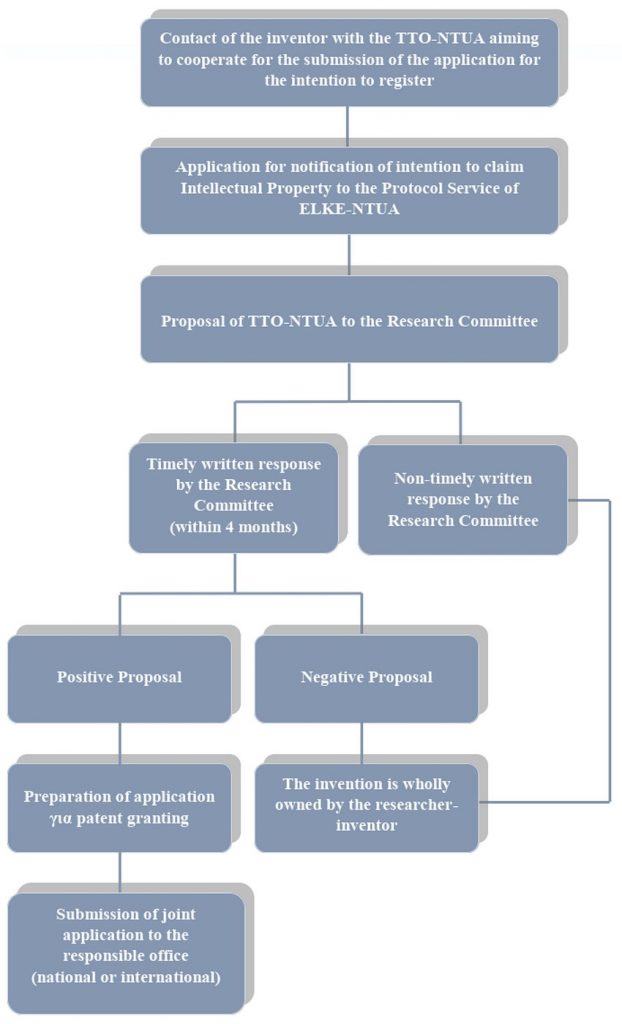The term “Intellectual Property” means both Industrial and Intellectual Property. More specifically:
“Industrial Property” consists of Patents, Utility Model Certificates, Modification Patents, Designs, Technology Confidential Information, Know-how and Trademarks.
The term “Copyright” refers to the rights to a “Work” that has been created. In this context, a “Work” is any original intellectual creation of words, art or science, expressed in any form, in particular written or oral texts, musical compositions, with or without text, audiovisual works, works of visual art, including drawings, works of painting and sculpture, engravings and lithographs, architectural works, photographs, works of applied art, illustrations, maps, three-dimensional works relating to geography, topography, architecture or science. Databases and software are also considered ‘works’.
The above are protected, where appropriate, by the following titles:
- Patent: An application for patent granting is required to the Industrial Property Organisation (IPO) and/or the European Patent Office and/or any Patent Office. The patent is granted for new inventions involving an inventive activity that are susceptible of industrial application. The invention may relate to a product, a method or an industrial application. The duration of its protection is 20 years.
- Modification Certificates (M.C.): M.C. is the protection title granted for an invention that is a modification of another invention that has already been protected by a patent and expires with it. M.C. may be converted into a patent after a request of its holder. For the resulting patent, the date of filing is considered as the date of filing of the M.C. The duration of its protection is 20 years.
- Utility Model Certificate (U.M.C.): The U.M.C. is a protection title with a duration of 7 years and is granted to the beneficiary who has invented three-dimensional objects with a defined shape and form, proposed as new, industrially applicable and with the potential to provide a solution to a technical problem. U.M.C. may be granted for e.g., a tool, instrument, apparatus, utensil, appliance, their component, etc.
- Intellectual Property Rights (copyright): Intellectual Property Rights are intangible rights that are acquired automatically for each type of original intellectual creation and include the right to exploit the “Work” (e.g., the right to reproduce the work, to present the work to the public) which is the economic right over the Intellectual Property and the right to protect the personal connection of the creator with the “Work” (moral right). The property rights are transferable while the moral rights, under Greek law, are non-transferable. Intellectual Property is protected for 70 years after the death of the creator of the Work.
Research can lead to an invention. Article 6 of Law 1733/1987 on technology transfer, inventions and technological innovation defines the 3 types of inventions:
α) “Free invention”: an invention made by the employee, without the employer’s resources, and wholly owned by him.
(b) “Service invention”: the product of a contractual relationship between an employee and an employer for the development of an inventive step. In this case, the invention is wholly owned by the employer.
(c) “Dependent invention”: an invention carried out by an employee(s) while using the materials, means and information of the company who have employed him. In this case, 40% of the invention belongs to the employer and 60% to the employee(s).
In case of joint/collaborative works of more employees when the invention is considered to be “dependent”, 40% of the rights to the invention belong to NTUA, while the remaining 60% will be shared among the inventors, unless is otherwise specified in a relevant inventor-NTUA or NTUA-funder contract. Researchers don’t need necessarily to participate with equal percentage of royalties.
The commercial exploitation of the invention may be carried out by means of an intellectual property licensing (or use) contract or a technology transfer contract or a know-how transfer contract.
The steps to be followed by the inventor for the notification of interest in submitting a joint invention application with NTUA and the approval procedure for the joint submission are illustrated in the following figure.




